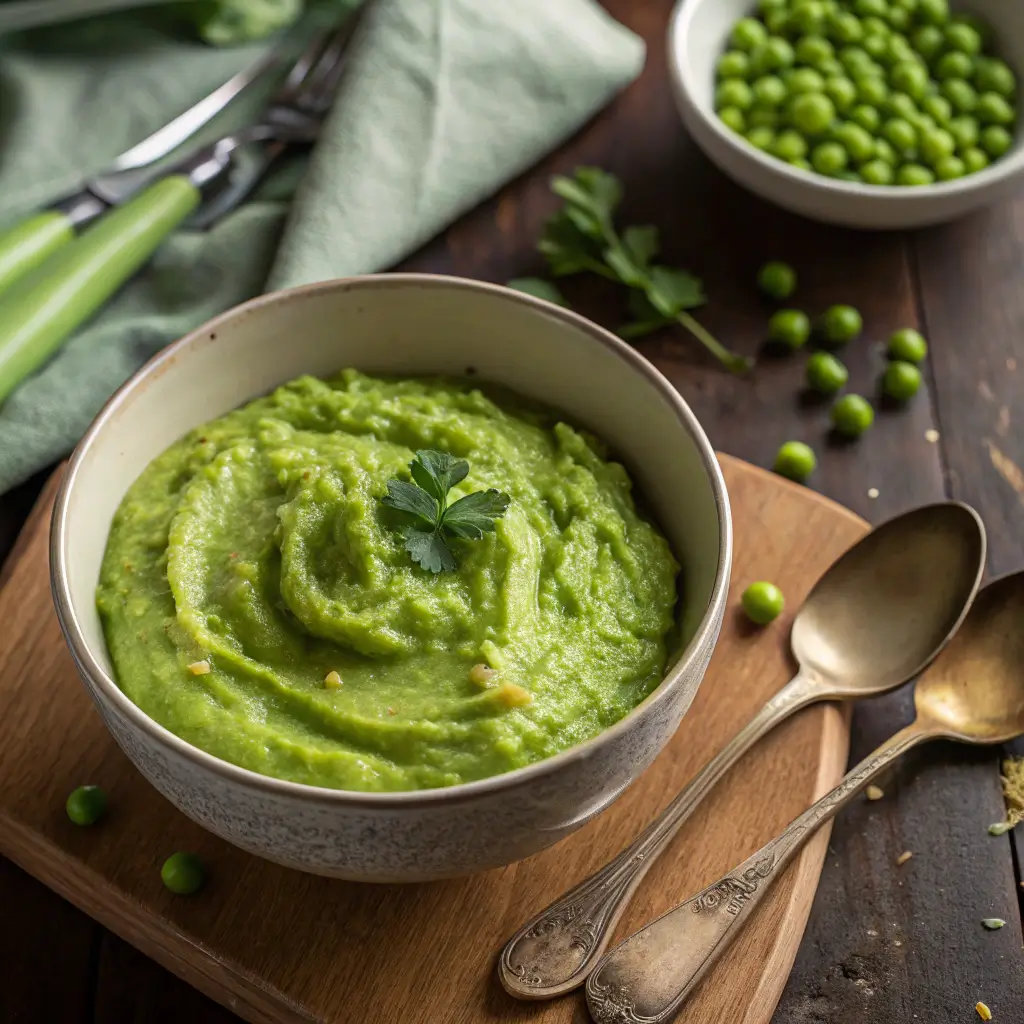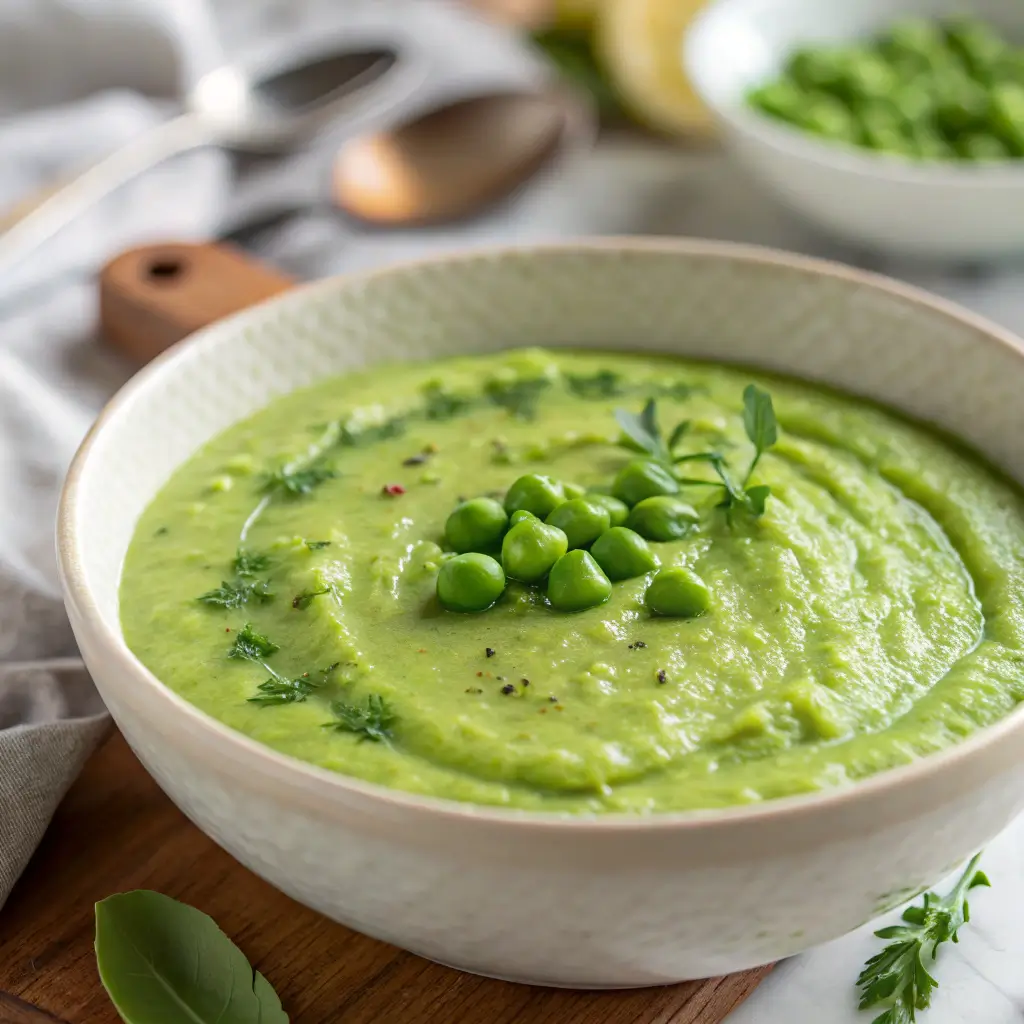Spring Pea Purée: A Vibrant, Fresh, and Versatile Side Dish
Introduction
Few foods capture the feeling of spring as beautifully as peas. Their natural sweetness, vibrant green color, and delicate texture make them the perfect ingredient for celebrating the season. One of the most delicious and versatile ways to showcase them is with Spring Pea Purée. This dish may sound refined, but it’s incredibly simple to prepare. With just a few pantry staples and fresh herbs, you can create something that feels both comforting and sophisticated.
Pea purée is more than just mashed peas—it’s a velvety, flavor-packed accompaniment that enhances whatever it touches. Its creamy texture works beautifully with proteins like chicken or fish, but it also shines as a vegetarian side or even as a dip with bread or crackers. The bright green hue makes it an eye-catching addition to any table, and its refreshing taste makes it a wonderful balance to richer mains.
If you’re looking for a dish that embodies freshness, versatility, and ease, this recipe deserves a place in your repertoire.

A Brief Background
Peas have been cultivated for thousands of years, prized for their nutritional value and adaptability. In Europe, particularly in French and Italian kitchens, pea purée has long been used as a refined base or garnish in fine dining. Chefs love it because it adds color, sweetness, and elegance without overshadowing the main component of the dish.
In home cooking, peas have often been overlooked in favor of potatoes or grains, but pea purée bridges the gap—it’s as comforting as mashed potatoes yet feels lighter and fresher. With frozen peas widely available, it has also become an accessible recipe year-round, not just in spring when fresh peas are harvested.
Why You’ll Love This Recipe
- Seasonal and fresh – Perfectly showcases spring produce.
- Quick to make – From start to finish, it’s ready in under 20 minutes.
- Flexible – Works as a dip, side dish, or elegant garnish.
- Healthy and nutrient-rich – Packed with protein, fiber, and vitamins.
- Crowd-friendly – Appeals to kids and adults alike.
Ingredients & Equipment
Ingredients (Serves 4–6)
- 3 cups fresh or frozen peas
- 1 small shallot, finely chopped
- 2 tablespoons olive oil or butter
- ½ cup vegetable or chicken broth
- 2 tablespoons fresh lemon juice
- 1 teaspoon lemon zest
- 2 tablespoons fresh mint leaves (optional, for brightness)
- ¼ cup heavy cream or Greek yogurt (optional, for richness)
- Salt and black pepper, to taste
Equipment
- Medium saucepan
- Slotted spoon
- Blender or food processor
- Fine mesh strainer (optional, for extra smoothness)
- Serving bowl
Step-by-Step Instructions
Step 1: Sauté the Aromatics
Heat olive oil or butter in a medium saucepan over medium heat. Add chopped shallot and cook for 2–3 minutes until softened and aromatic. This creates a savory foundation for the purée.
Step 2: Simmer the Peas
Add peas and broth to the pan. Simmer for 3–4 minutes until the peas are tender and bright green. Be careful not to overcook—this preserves both sweetness and vibrant color.
Step 3: Blend Smooth
Transfer peas and shallots to a blender or food processor. Add lemon juice, zest, and mint leaves. Blend until smooth, adding a little cooking liquid at a time until you achieve a creamy consistency.
Step 4: Enrich and Season
For extra creaminess, stir in yogurt or cream. Season with salt and pepper to taste. For a professional touch, push the mixture through a fine mesh sieve for a silky finish.
Step 5: Serve Warm or Chilled
Transfer to a serving bowl and garnish with a drizzle of olive oil or a sprinkle of herbs. Serve immediately while warm, or chill for a refreshing dip.
Expert Tips & Troubleshooting
- Avoid overcooking – Overdone peas lose their sweetness and vibrant green color.
- Adjust consistency – For a thicker dip, use less liquid; for a looser sauce, add more broth.
- Frozen peas are ideal – They’re flash-frozen at peak ripeness, often sweeter than fresh.
- Balance flavors – Lemon keeps the purée bright, while mint adds freshness.
- For ultra-smooth texture – Strain the purée after blending.
Flavor Variations
- Herb-focused – Use basil, parsley, or dill instead of mint.
- Cheesy – Add a handful of Parmesan for a nutty depth.
- Spiced – Mix in cumin, coriander, or chili flakes for warmth.
- Nutty – Top with toasted almonds or pine nuts for crunch.
- Citrusy twist – Swap lemon with lime or orange zest.
Nutritional Benefits
Peas aren’t just tasty—they’re nutritional powerhouses:
- Protein-rich – Great plant-based protein option.
- High in fiber – Aids digestion and keeps you full.
- Vitamin-packed – Especially vitamin C (immune support), vitamin K (bone health), and B vitamins.
- Antioxidants – Help protect cells and reduce inflammation.
- Low in fat – Light and heart-healthy.
Adding olive oil contributes healthy fats, while mint and lemon bring antioxidants and vitamin C. If you use yogurt instead of cream, you’ll also add probiotics for gut health.

Serving Suggestions
Spring Pea Purée is endlessly adaptable. Try it:
- As a side – With roasted chicken, grilled salmon, or lamb.
- As a sauce – Under pan-seared scallops or shrimp.
- With pasta – Toss into spaghetti or gnocchi for a creamy green sauce.
- As a spread – On crostini, topped with goat cheese or smoked salmon.
- For brunch – Pair with poached eggs and crusty bread.
Storage & Make-Ahead Tips
- Refrigerate – Store in an airtight container up to 3 days.
- Freeze – Portion into small containers, freeze up to 2 months, and thaw overnight in the fridge.
- Reheat – Warm gently on the stove with a splash of broth to refresh texture.
- Make ahead – Perfect for prepping the day before a dinner party.
FAQs
Q: Can I make it dairy-free?
Yes, simply skip the cream or yogurt and use extra olive oil for richness.
Q: What’s the difference between pea purée and pea soup?
Pea purée is thicker, often used as a side or sauce, while pea soup is thinner and eaten as a standalone dish.
Q: Can I use this as baby food?
Yes—just omit salt and lemon juice for a baby-friendly version.
Why This Recipe Works
The success of this dish comes down to balance. The natural sweetness of peas is lifted by lemon’s acidity and complemented by aromatic herbs. A touch of cream or yogurt adds body, but the dish remains light and refreshing. Cooking the peas just until tender ensures they stay bright and flavorful, while blending creates a silky-smooth result.
Conclusion
Spring Pea Purée is a celebration of everything fresh and bright about the season. It proves that the simplest ingredients, prepared thoughtfully, can create something elegant and versatile. Whether you spoon it under roasted fish, spread it on crostini, or serve it as a simple side, this recipe will bring a burst of springtime freshness to your table.
It’s quick, customizable, and nutritious—everything a modern cook could want in a recipe. Give it a try, and you may just find yourself making it not only in spring, but all year long.
